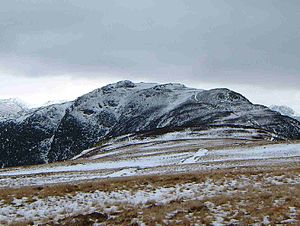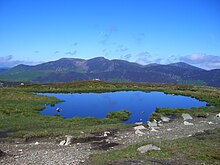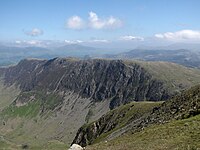High Spy
| High Spy | |||
| Cumberland | |||
|---|---|---|---|
 High Spy from Maiden Moor | |||
| Range: | Lake District North Western Fells | ||
| Summit: | 2,142 feet NY234162 54°32’2"N, 3°11’6"W | ||
High Spy is a fell in the Lake District, in Cumberland it is situated on the ridge that separates the Newlands Valley from Borrowdale, five miles south of Keswick.
The meaning of the fell's name is obscure but may mean a “look out post” referring to some lost fort in the area. In the past it has been known as Scawdel Fell and Lobstone Band and these names are still used on maps to label other parts of the fell.[1]
Landscape

The fell reaches a height of 2,142 feet and is defended by crags to the east and west as it falls away steeply to the valleys. It is a distinctive fell that has 486 feet of topographic prominence from the higher, adjoining fell, Dale Head and so misses being a 'Marilyn' by only six feet. Geologically the fell is made up of 'Borrowdale volcanics'.

The summit has an impressive cairn (which has been known to be vandalised on a few occasions but always seems to get rebuilt by other walkers). The top of the fell is relatively flat for a distance of about a mile and a half in a north to south direction and the impressive Eel Crags fall away vertically on the Newlands side of the fell, these crags are popular with rock climbers, the quality of the rock being very good.
High Spy North Top (NY236171) stands half a mile north of the main top and has a height of 2,080 feet: it is significant enough to be included in the 'Nuttall' list. The North Top gives a fine view of Derwent Water.
650 yards north of the main summit is a small unnamed tarn.[2]
Ascents
High Spy is often climbed as part of the Newlands Horseshoe ridge walk but can be ascended directly despite being defended by crags on both its Newlands and Borrowdale sides.
From Borrowdale a path goes from Rosthwaite and climbs through the disused Rigg Head Quarries to reach the col linking High Spy to Dale Head and then up the south ridge to the summit passing a small unnamed tarn just before the top. From this side it is also possible to start from Grange and use an old drove road to get through the barrier of Blea Crag and then approach the summit.
A scrambling route also starts from Grange, going via Hollows Farm it tackles the rocky rake of Nitting Haws directly.[3]
From Little Town in the Newlands valley an old mine road zig zags up to the col between the fell and Dale Head to then reach the top by the south ridge.[4][5]
Mining
The latter route passes the Castlenook lead mine at the foot of the fell on the Newlands side, this mine, formerly owned by the Company of Mines Royal, started production in the 1860s and continued until 1918 when cheaper imports led to its closure.
There are also signs of trial levels higher up the steep slope.[6]
References
- ↑ ukonline.co.uk. details of fells name and translation.
- ↑ "The Mountains of England and Wales Vol. 2 - England", John & Anne Nuttall, ISBN 1-85284-037-4, Page 34 Gives route details and info on North Top.
- ↑ "Scrambles In The Lake District - North", R. Brian Evans, ISBN 1-85284-463-9, Page 138 Gives details of scrambling route from Grange.
- ↑ Wainwright, Alfred: A Pictorial Guide to the Lakeland Fells, Book Six — The North Western Fells (1964)
- ↑ Bill Birkett: Complete Lakeland Fells, ISBN 0-00-713629-3, gives general details of fell and routes
- ↑ :Old Cumberland Gazeteer - Castlenook mine